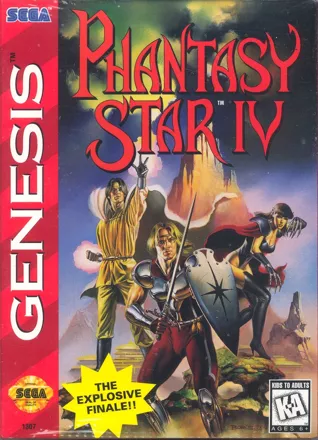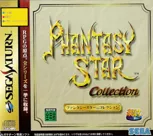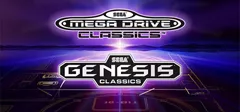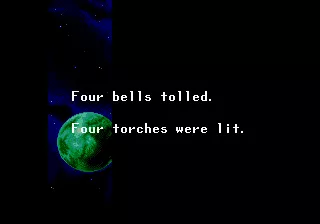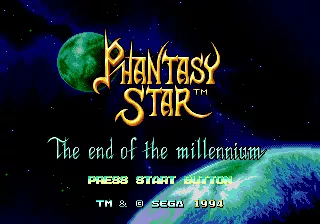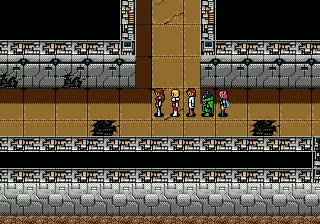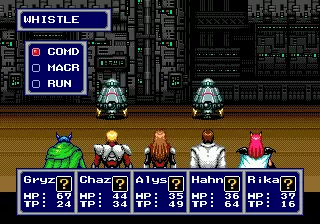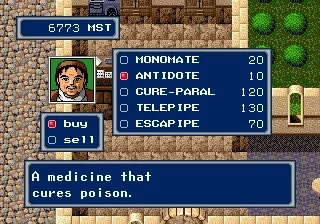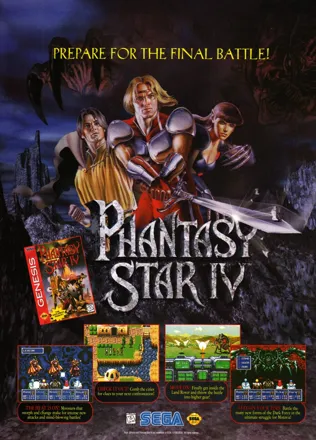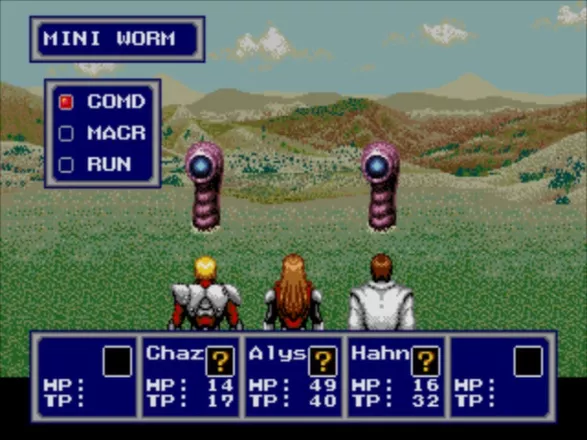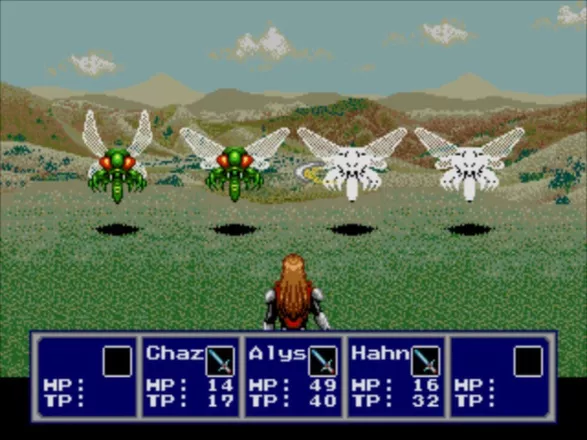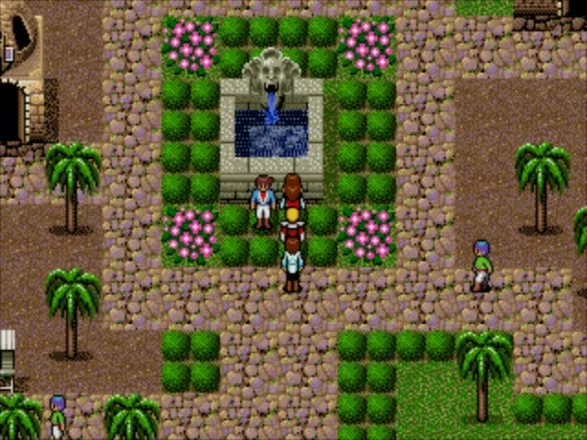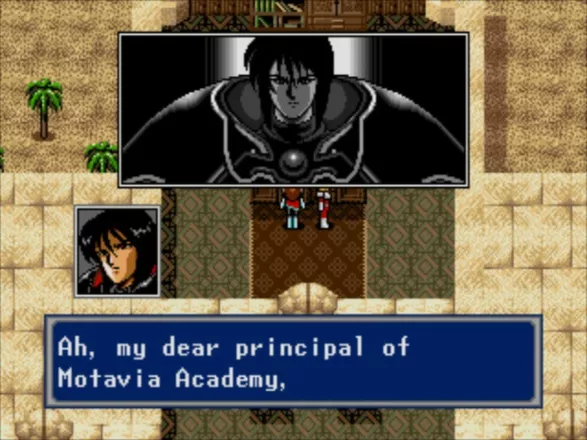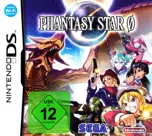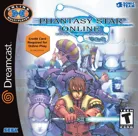Phantasy Star IV
Description official descriptions
The Algol star system is in troubled times. Many thousands of years ago, it was a peaceful world. Three planets surrounded the Algol star and were in perfect harmony: Palma, a lush green planet, where its citizens devoted their lives to arts and the sciences; Motavia, a desert planet, inhabited by humans and native Motavians; and the enigmatic Dezolis, a harsh ice planet, where the citizens were just as unknown as the planet itself. Unfortunately, the harmony and balance was not to last. Palma had exploded, and with it, ninety per cent of Algol's population died. Motavia had fallen into horrible conditions from the explosion, turning almost into a total wasteland. The Darkness spread its hand over the land.
A thousand years have passed. Motavia has healed somewhat, and life is beginning to return to the way it once was many years ago. The Hunter's Guild on Motavia helps to keep things steady. But a dark evil once thought to be long dead is beginning to stir once again, and the young hunter, Chaz, is about to begin his ultimate adventure - which starts with one simple routine assignment...
Phantasy Star IV is a Japanese-style role-playing game with top-down world map exploration, random enemy encounters, and turn-based combat. The gameplay of the fourth entry in the series is similar to that of the second installment, sharing notable features such as the ability to equip two weapons at once, most of the "techniques" (equivalent to magic spells in comparable games), etc. The dungeons are noticeably less maze-like than in Phantasy Star II. Player-controlled party may include up to five active combatants.
As before, leveling up and technique-learning is automatic, save for android characters, whose abilities are found in treasure chests in the dungeons. Androids also cannot be healed by conventional means and use their own item sets. Beside regular attacks and techs, characters also possess unique attacks that have limited uses and can be replenished after the character rests. Characters can also execute combination attacks, merging two or more techs or special attacks. The player may opt to assign macro command sets for the party instead of inputting commands manually.
There are a few segments in the game with vehicle combat, which mostly follows the same turn-based formula as the regular battles. Side quests are present in form of hunter assignments for Chaz and his friends. A "party talk" feature is available, displaying conversations between player-controlled characters. The game uses manga-style comic book panels as cutscenes.
Spellings
- ファンタシースター ~千年紀の終りに~ - Japanese spelling
- 梦幻之星4 - Chinese spelling (simplified)
Groups +
Screenshots
Promos
Videos
Add Trailer or Gameplay Video +1 point
See any errors or missing info for this game?
You can submit a correction, contribute trivia, add to a game group, add a related site or alternate title.
Credits (Genesis version)
66 People (39 developers, 27 thanks) · View all
| Original Story |
|
| Script |
|
| Sound Director |
|
| Battle System Planning |
|
| Battle Programming |
|
| Assistant Battle Programming |
|
| Monster Graphic Design |
|
| Battle Background Design |
|
| System Planning |
|
| System Programming |
|
| Assistant System Programming |
|
| Field Graphic Design |
|
| Character Design |
|
| Mechanic Design |
|
| Map Design |
|
| Object Design |
|
| [ full credits ] | |
Reviews
Critics
Average score: 82% (based on 25 ratings)
Players
Average score: 3.9 out of 5 (based on 96 ratings with 4 reviews)
This is the one game I don't believe I'll ever get bored with i.e best game ever
The Good
I first played this in 1997 and have replayed it so many times, somehow never managing to become over-familiar with it. Whenever I play it, I seem to understand better why I like it so much and sometimes notice little flaws that perhaps could be tweaked. Over time, I've learned to appreciate how much work went into it, I believe that the team was trying to give the players a really epic story experience, unlike previous Phantasy Star games where you're kind of given a skeletal story and forced to flesh it out in your mind and create the gaming experience yourself. I think the difficulty level is just about right, I was almost a complete rookie in turn-based combat when I first played it and being such a long game, it gives you the first few battles at little cost, slowly challenging you more and more. I've gotten better and better at the game and don't sweat the battles like I used to, but they can still be pretty edge of your seat, after all, your success is still quite dependent on luck i.e which party member the computer targets, with which attack. The game has mostly done away with "grinding", which is a huge help in my book. So long as you don't evade too many battles, comb all the dungeons for armour upgrades and make the most of your techniques and skills, you should be able to afford armour upgrades from shops and beat bosses i.e you shouldn't find yourself utterly crushed by a boss, leading you to go about in circles, leveling up.
I think there is a lot to take from the game's story. Overall it's meant to bring an end to the series, explaining the origins of "Dark Force" from the previous games and presenting a "make or break" situation for Algo. One large theme running through the game is "science and legend". Though most of the party members are magic wielders, their logical attitudes suggest that their magic is some advanced form of science. Your party thinks logically to determine the root of a problem, but is willing to put faith in superstitious ideas e.g planet Dezolis is plagued by bad snow storms, logic says they're caused by a fault in the planet's weather control system, but there's also this idea among the Dezolisians that this mysterious, "evil" tower, is the source of the problem. There is a sort of climactic point in the game where one of the characters rebels against blindly trusting ancient stories and legends, which leads to a scene where he sort of discovers his purpose, what he believes in, his reason for fighting etc. I think the game's story has a lot in it and one can keep gaining from it, from replaying the game and experiencing it again.
The Bad
I think there's some attempt at presenting men and women as equal, though ultimately I think the male characters Chaz and Rune dominate a little. I think the team deserves credit for female characters like Alys and Rika, neither of whom I would call female stereotypes, two of the most interesting female characters I've come across. But though Rika has her moments, the game gets to a point where it seems to be mainly about Chaz and Rune and their difficult friendship. I think the game could be better if they'd found a way to mix Rika in with Chaz and Rune a bit more. As for Wren, I suppose his inclusion in the main plot is quite respectable considering he's a cyborg, albeit a relatively human one. There is some rather undisguised ill treatment of Raja though, not necessarily because he's a green-skinned Dezolisian, but because he's elderly i.e they call him an "old fart", resent having to "drag him around" and call him their "strange, travelling companion" even though he's clearly equal in terms of usefulness in battle.
The Bottom Line
I'd recommend it to anyone, even those who hate RPGs. The game is kind to players new to RPG, I was lucky enough to play this game before most other RPGs. It's worth any hardship to experience the story, which is of course told in a comic strip form, some very nice artwork. On top of all this, some excellent music by Izuho Takeuchi and Masaki Nakagaki.
Genesis · by Andrew Fisher (700) · 2018
Proving that Final Fantasy Is Not The King RPGS
The Good
Phantasy Star IV, was always one of my favorite games. Yet my original review for it kinda sucked. Furthermore I noticed a certain review for the game has been changed for the worse. Who changes their views seemingly at the drop of a hat?
After many delays PSIV was finally released in 1994. It was hailed as the “finale” of the Phantasy Star series. The game also cost an unbelievable $100! Was the hefty price tag worth it? Hell yes!
In Phantasy Star IV, we return to the Algol Solar System. 1000 years have passed, since Rolf and company destroyed the Mother Brain. This necessary event sent the Algol system into a decline. Now things are finally returning to normal. Yet an ancient terror lurks in the darkness, soon it will be reborn and unleash its terrible vengeance on the worlds of Algol!
This is were you come in. Players are thrust into the role of Chaz Ashley. An apprentice hunter, learning from the best Alys Brangwin, famed across Motavia, for her skill dispatching deadly bio-monsters. A routine mission to dispatch some of the creatures leads Chaz on a quest that will bring him face to face with Dark Force in all it’s dark glory.
This may not sound terribly original today, but keep in mind that Phantasy Star introduced the now common “dark god” hell bent on death and destruction. Furthermore the Phantasy Star series has always managed to pull this type of plot of effectively. And the story is well-presented and easy to follow, and enjoy, and in the end is that not what RPGS are designed to do? The plot never seems trite unlike in certain Final Fantasy games.
The game has plot twists, and many villlains including the enigmatic Zio and the return of Lashiec. And the boss fights are huge and great fun.
My opponent claims that there are is no conflict. Yet I remember a very interesting scene, in which the main character questions his role, and makes the point that if he blindly follows the will of the Great Light how is he any different that Zio or Lashiec. If that is not conflict what is?
There is also a tragic event in the game. Which my opponent claims is the same as the tragic event in Phantasy Star II. Yet they could not be MORE different
Along the way Chaz will meet eight others that will join in his quest. All the characters are unique and have different backgrounds. Sega even took the trouble to make each character has a unique way of speaking. While saying the same thing they all say it a different way. For example if you examine and area and there is nothing to see Wren will say"There are no anomolies ahead." While Rika will say, "This is boring!" It is this kind of attention to detail that always made the Phantasy Star series miles better than the overrated Final Fantasy series.(Admit it fanboys there are only like 2 good Final Fantasy games. And 2 out of 12 is a terrible track record.)
Battle monsters and explore towns and dungeons as the story gradually unfolds with manga-style cut scenes. That are just as cool today as they were ten years ago. My opponent claims that there is little originality in this game yet, if it were not for these ground breaking cutscenes, the modern RPG would not be the same...interesting.
The battles are most reminiscent of PSII. With much improved visuals. As with all the visuals. Five instead of four party members in your party is also a welcome addition. During battles the usual choices are available, weapons, techniques (Magic is PSIV) and running from battle. As well as new skills. Skills work like techniques except, they cost no TP, instead each one can be used a certain amount of times. For fighter types like Chaz skills will play a more crucial role in defeating “boss” monsters.
Battle speed is much better than in previous installments. And in RPGS in general. The battles are never drawn out, as the sometimes were in PSII and PSIII. And almost always are in Final Fantasy. You even increase or decrease the speed.
Techniques and skills can even be combined to create more powerful combo attacks.(For example Rayblade + Astral= Paladin Blow a very power and very cool looking attack. Some are very hard to discover and will take quite a bit of experimenting particularly the 'Destruction' combo. These are among some of the most powerful and awesome to watch executed. So finding them will be well worth your time. My opponent claims that there are only spells and standard attacks. And does not mention the original skills like Crosscut. Most likely to strengthen his argument that the game is unoriginal. (Yet he defends FFV which is a step back for the series. With it's non-existent plot and bland characters. And simply moronic class system.)
The music in PSIV is excellent. Up to par and usually better than any other RPGS of all time. What makes it so good is how unique it is. There are no pretentious “classical” themes. The music tends to be much more techno inspired. Some of the tunes in particular stand out. “Ooze” the song played when fighting the end boss, is quite possibly the greatest song ever composed for a video game. The music does not lack variety. Both the composers from PS1&2 as well as from PS3 lend their talents for this one. Their different styles lend to a well-rounded soundtrack.
The graphics in Phantasy Star IV are easily the best in the series. The sprites are more well formed than the atypical short and stocky types found in most 2D RPGS. In battle the characters come to life in huge over the shoulder sprites. They charge the enemy and attack, unlike Final Fantasy. And the monsters are large and animated. Nowadays this is common place but remember that the "great" Final Fantasy series did not animate the monsters untill FF7...so suck it fanboys.
There are many little details in this game that Final Fantasy games lack. The towns are chock full of details, from seeing ducks swimming in a pond, to townspeople sweeping up, etc.
Every dungeon is unique. One has you use pedestals to open up new levels. While another you may need a special item to progress. Many are very difficult as well such as Lashiec's castle.
The setting is also quite different. Sure, it is the same worlds, but the tone is different. In Phantasy Star II, most people enjoy there "perfect" world, that on a deeper level is far from perfect. Where as in Phantasy Star IV the world has just recovered from a near collapse, and is much more crude.
And while Phantasy Star II had a great cast, PSIV eclipses it, as the cast is more varied. In PSII only one party member is NOT human. While in PSIV, there are Androids, Motavians, and Dezolians.
Phantasy Star also helped inspire some of my other favorite RPGS like Arc the Lad, Star Ocean, and the Lunar series.
The Bad
There is NOTHING bad in PSIV. It amazes me that Sega could fit this game on a cartridge. And still have such a good game. Then again it was going to be Sega CD game. It was to be and even bigger game, as many features had to be removed to fit it on to a cart.
It would have been interesting to see what the Sega CD version would have been like.
The Bottom Line
Phantasy Star IV, wraps the series quite nicely. It is the biggest game of the series, with a 24-meg cart! Not only is it best RPG the Genesis, it is one of the, if not the best RPG all time. I have played this game like 20 times over the years and still play it to this day and still enjoy it every time.
The Super Nes may have had MORE RPGS but the Genesis have a few that really shine. Hell this game really shows how inferior Final Fantasy is. Just as Landstalker shows how inferior The Legend Of Zelda is.
Genesis · by MasterMegid (723) · 2007
Good flow, slightly mediocre content
The Good
Being released during the golden age of 16-bit CRPGs, Phantasy Star IV took some of the best qualities of the Dragon Quest and Final Fantasy series and gave them its own spin. The game features a Star Wars-esque mixture of epic battle deeds of an adventuring party, set in a refreshing sci-fi setting with a heavy dash of anime seasoning.
The adventure plays straightforward, told in a crisp manner with very little idle time between adventures. Where 16-bit Final Fantasies often dwelt tediously on situations and early Dragon Quests offered way too little plot, Phantasy Star IV found a good measure between the two that doesn't interrupt the gameplay's flow.
This carries over into the battles, one of the game's strong points. The parties comprised of up to five characters require a pleasant amount of tactical thinking. Text information, combat animation and battle summaries are concise, making the many random encounters just long enough. Clever damage and XP balancing result in a perceivable character progression. Although a watchful eye must be kept on characters' hitpoints, extensive dungeon crawls are actually explorations, not gradual advances interrupted again and again by overpowered enemies forcing a retreat to the nearest town.
Outside of combat graphics are functional rather than fancy, although personally I appreciate it that character sprites aren't super-deformed compared to their surroundings and that the whole party can be seen while wandering around rather than the lead character representing everyone. In battles characters are even more realistically proportioned and overall appropriately sci-fi-looking. Dropping the 3D dungeon view of the early Phantasy Star instalments, the battle view focuses on the enemies like in Dragon Quest. However, it also shows active party members from behind, rushing forward to deliver blows, which creates a nice and almost cinematic way of presenting encounters.
A trademark feature of the game, its cutscenes deserve special notice because they are presented as fully illustrated and very effectually arranged comic book panels which are visually superior to mere text boxes or the use of limited sprite animation to tell the plot.
On the same note, I must admit at this point that generally I despise the Sega Genesis' sound capabilities. If (arguably) nowhere else, the SNES was clearly superior to Sega's machine in that department. Surprisingly, the soundtrack of Phantasy Star IV is very decent. While not as orchestral and rich as the best pieces the SNES has to offer, the techno-influenced musical style of Phantasy Star IV seems to fit the Genesis' sound chip perfectly, rather gracefully dodging the flat and scratchy tunes heard in so many other games.
The Bad
Like most Japanese CRPGs of its time, Phantasy Star IV plays extremely conservatively. Its gameplay formula is a strict "rest and resupply in towns - overworld map - isometric dungeons - random battles" procedure, looped ad infinitum and set in a linear story with linear character development. It takes players' willingness to see beyond those unoriginal aspects to discover what actually sets Phantasy Star IV apart. The real qualities lay mainly in the details.
Graphically, Phantasy Star IV doesn't disappoint although enemy and scenario depictions in the separate battle screens are noticeably better than in the isometric overworld, town and dungeon views. It is solid 16-bit fare and little else.
The cutscenes are perhaps the game's most outstanding visual feature but they were designed in a generic anime style by today's standards. The very idea was unusual for its time to be sure but whether or not one finds the character designs overly outstanding is a matter of taste. Personally, I find Akira Toriyama's quirky Dragon Quest designs more appealing, considering TV shows like Saber Rider had already established a character style comparable to PSIV even in Western regions.
The plot is carried mostly by its setting as the characters populating it are for the most part classic fantasy stereotypes outfitted with sci-fi weapons. The writing itself adheres to many clichés, be it the sword-wielding, youthful firebrand hero or the dark, sorcerous overlords who reveal themselves and their plans only gradually which seems to be directly related to the heroes' party level. Thankfully, the game isn't bereft of humour or exciting moments but the impression of 'seen it, give me more' is often hard to shake.
The Bottom Line
What Phantasy Star IV copies it copies well. What little it does differently it does very well. Above all else, the game is a joy to play because its main gameplay aspects, combat and exploration, are well balanced. Although repetition cannot be denied, Phantasy Star IV tends to not get as tedious as many of its better-selling rivals at their worst.
While the series isn't as expansive or successful as other 16-bit CRPGs, especially Phantasy Star IV holds up even today. The game isn't punishingly difficult or so flawed that only die-hard fans can tolerate its shortcomings. Instead it is nothing less (or more) than a solid experience with an excellent gameplay flow.
Genesis · by Kit Simmons (249) · 2010
Trivia
Character name differences
Almost all the names of your party members in the game were changed in the English translation. Some changes were probably necessary, since there was a four-letter limit for names written in Latin letters, while the Japanese could write longer names with their kana (syllabic letters). Other changes are seemingly without any reason.
Here are the names in Japanese and English versions, respectively:
Japanese: Rudy, Fal, Lyla, Pyke, Thray, Forren, Freyna, Shess.
English: Chaz, Rika, Alys, Gryz, Rune, Wren, Demi, Kyra.
Cut content
Many items did not make the final cut in Phantasy Star IV: the Blood Axe, a weapon for Gryz; a map similar to that of Phantasy Star III's "monitor"; a technique that when used was to fully restore your party, like healing at an inn (called "Resta" if memory serves correctly), as well as the return of the Skure Spaceport and the Nei Dungeons from Phantasy Star II.
These appeared in a beta version of the game and can be accessed via a ROM. But the Skure and Nei Dungeons cannot be entered.
Development
- Phantasy Star IV was at one point going to be a Sega CD title, but about midway through development, Sega promptly cancelled the Sega CD version and stuffed it onto the Sega Genesis instead. This was probably done because of the low sales figures for the Sega CD.
- Phantasy Star IV like the original Phantasy Star, was going to have 1st person dungeons, and battles. This was later dropped, in favor of the more common, 3rd person perspective.
Manual error
In the English Phantasy Star IV manual, it is written that there are 15 combination attacks, when there are actually only 14.
References
- There are books on the bookshelf in Saya's house that reference Sonic the Hedgehog, Ecco the Dolphin, and Golden Axe.
- There are cameos from previous Phantasy Star characters. Alis, and Myau appear and speak to you, while the rest of the cast of Phantasy Star and Phantasy Star II also make a non-verbal appearance.
Information also contributed by אולג 小奥 , MasterMegid, and Tiago Jacques
Analytics
Upgrade to MobyPro to view research rankings and price history! (when applicable)
Related Sites +
-
OC ReMix Game Profile
Fan remixes of music from Phantasy Star IV. -
Phantasy Star Wiki
A comprehensive database that covers the characters, locations, items and games in the Phantasy Star series.
Identifiers +
Contribute
Are you familiar with this game? Help document and preserve this entry in video game history! If your contribution is approved, you will earn points and be credited as a contributor.
Contributors to this Entry
Game added by Satoshi Kunsai.
Wii added by Picard. Nintendo Switch added by Kam1Kaz3NL77. Windows added by Sciere. Macintosh, Linux added by Foxhack.
Additional contributors: Unicorn Lynx, Guy Chapman, Sciere, Alaka, j.raido 【雷堂嬢太朗】, —-, Thomas Thompson.
Game added June 6, 2002. Last modified February 25, 2025.


